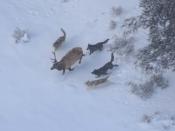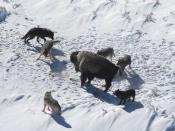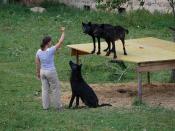The Pearl: Canine Imagery Essay Today, when people in our society think of "dominance," they tend to cringe at the thought, perhaps because of the negative connotations we attach to it. However, in the "animal kingdom," dominance is viewed in a totally different perspective. The animals distinguish dominance as the glue that holds them together. To animals, it is simply a matter of leadership, pecking order as some call it. In John Steinbeck's, The Pearl, Kino, a poor fisherman finds a pearl that may lead him to a wealthy lifestyle, but later is suppressed by a hierarchy that wants to remove any belief he has of improving his station in society. In an animal's social order, heightening one's position is not thought of. Each animal understands that it is either above or below another animal, and conducts itself based on that realization. On the other hand, it is expected of humans to yearn for more.
Hence, when greed plays an insidious factor in trying to attain a higher status, falling out of one's "intended place" can spawn reoccurring, uncontrollable changes in a man's behavior. Canine imagery in The Pearl shows how avarice reduces men to predatory animals.
By the manner in which they conduct themselves, the pearl buyers have a deep connection with wolves. The first incident in the novel to express how gluttony dehumanizes a man to a primordial animal is when "[Kino] feels the creeping of fate [and] the encircling of wolves" as he attempts to sell his rare pearl. Here, the images of wolves allude to the pearl buyers, who possess an insatiable appetite for Kino's "Pearl of the World" to satisfy their own greedy ambitions. In a pack of wolves, the young, or "the workers," under the alpha male, find an area to reside in and mark it with their own scent. In the same way, the pearl buyers operate under one leader but run their shops with different names. At the first word of Kino's findings, the pearl buyers, within their separate sections of town, gather to conspire and trick Kino into relinquishing his pearl for a mere portion of its actual value. Closely correlated with the pearl buyers' actions is the communal howling of wolves, which serves as a call to assemble its members. Just like wolves, the pearl buyers select their kill based on the prey's weaknesses. Wolves tend to look for old and less agile animals to feed on. Referring to the story, Kino is singled out due to his ignorance, contrary to his educated counterparts, the upper class, which would not be so easily influenced or pliable. Now assembled, the pearl buyers instinctively "encircle" Kino, slowly enclosing him. Depicted as merciless wolves, the pearl buyers display no signs of clemency. Kino is trapped with nearly no possibility to protect himself. To further reinforce their likeness to wolves, which are known for their rapaciousness, the pearl buyers travel in a band, "or pack". The pack's strength in number ensures the overall effectiveness of the outcome. Both wolves and the pearl buyers retain the strong "prey-drive" instinct and attack suddenly and savagely. To wolves, out on the frosty plains, they are compelled to strike at the first available sign of a weak prey because the wolf is unaware when its next meal will be or when the next prey will arise. Why take the chance of risking starvation? To attack at the first immediate sign is to ensure its survival. Similarly, the pearl buyers are not sure if another man will ever walk in with a "Pearl of the World" and therefore attack Kino at the first chance. It may not be because they are overtaken by viciousness, but because something triggers the "predatory-prey response." The motivating dynamic in this story is avarice and the belief that more money will let the pearl buyers "survive". The difference between the wolves and the pearl buyers is that wolves are obligated to hunt and attack because it is their nature and the only aspect that allows them to live. On the other hand, the minds of the pearl buyers equate "surviving" to owning more possessions and money, which is rather recognized as greed, a dehumanizing force.
Ironically, Kino, also, exhibits predatory behavior. Conveyed to the reader through an attempt to regain the pearl that his wife, Juana, is ready to discard, Kino's deterioration progresses as "he quietly tracks her." Predators are quite sensitive to motion, and when Kino, the voracious animal he has now become, sees Juana meandering outside with the pearl, he is drawn to her, as wolf is drawn to its prey. Kino, the ruthless prowler, based on instinct, chases Juana and immediately beats her. At this point, Juana, herself, realizes she is the prey at the mercy of Kino. Nevertheless, after glaring down at her, Kino exhibits no remorse for his actions and "looks down at her with his teeth bared." Generally, wolves and canines have sharp, fang-like teeth, which stick out from their mouth, able to be seen. As a means of intimidation, Kino "bare[s] his teeth" closely identifying to wolves baring their canines as they growl at their prey. By now, Juana realizes that Kino's unleashed fury has lead her to recognize that she has been reduced to an animal; that she is now the victim of Kino's rampage and as a result, she capitulates. Now acting as Kino's perceived enemy and prey, Juana "stare[s] at him [Kino] with wide unfrightened eyes, like a sheep before the butcher." Juana, the sheep, is virtually defenseless and has no recourse to use to her advantage. This creates the illusion of a sheep before the butcher, which knows that it cannot do or prevent anything, and therefore, willingly sacrifices itself as Juana does. Steinbeck uncovers a predatory instinct in Kino, but the difference is that wolves hunt to survive; Kino "tracks" for the sake of his pearl, which he believes he can no longer live without, once again, proving that Kino is driven by avidity. Kino's infatuation with the pearl has caused him to disintegrate into a violent, abusive animal that victimizes those who dare defy him.
In conclusion, Steinbeck, through the use of canine images and metaphors, emphasizes that acquisitiveness disintegrates a man into primitive, predatory animals. His message is that when man "tries to obtain that which is unattainable," it proves to be more harmful than beneficial. He states that it is normal human behavior to want more, but to become excessive, is to become greedy, thus, causing devolution. I think Steinbeck would like everyone to recognize social order and the fact that it exists for good reason, which we must learn to use to our advantage. The quest to leave the prescribed social order is understood, but to be overlaid with greed can be destructive. If something is desired so greatly, a balance between "the wanting" and practicality should be present. Handling situations of normal ambitions must be approached tactfully in order to prevent ravenousness from forming. The journey "to break barriers" is difficult enough without being blinded by the evil monster known as avarice. Instead of allowing "greed to be a dehumanizing force," let us rather enjoy our station in life and not take for granted what we do have. It is said that God has put us all here, strategically, for a specific purpose, and it is that sole purpose, which we must learn to understand and embrace.
by: s.d.





